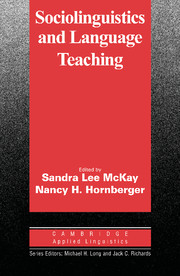Book contents
- Frontmatter
- Contents
- List of contributors
- Series editors' preface
- Preface
- Acknowledgements
- Part I LANGUAGE AND SOCIETY
- Part II LANGUAGE AND VARIATION
- Part III LANGUAGE AND INTERACTION
- 8 Ethnographic microanalysis
- 9 Interactional sociolinguistics
- 10 Intercultural communication
- Part IV LANGUAGE AND CULTURE
- CONCLUSION
- Index
10 - Intercultural communication
Published online by Cambridge University Press: 22 July 2009
- Frontmatter
- Contents
- List of contributors
- Series editors' preface
- Preface
- Acknowledgements
- Part I LANGUAGE AND SOCIETY
- Part II LANGUAGE AND VARIATION
- Part III LANGUAGE AND INTERACTION
- 8 Ethnographic microanalysis
- 9 Interactional sociolinguistics
- 10 Intercultural communication
- Part IV LANGUAGE AND CULTURE
- CONCLUSION
- Index
Summary
Introduction
This chapter is distinguished from those that immediately precede and follow it because it does not present another approach to the study of language use. Rather it examines answers that sociolinguists associated with the approaches outlined in the chapters on ethnography of communication, ethnographic microanalysis, and, especially, interactional sociolinguistics and speech act theory have given to questions concerning the miscommunication that often occurs when people with different life experiences and different cultural patterns of communication interact with one another. The chapter is concerned, in particular, with the answers that have been given to these research questions:
What are the sources of intercultural miscommunication?
What are the social effects of such miscommunication?
What can be done to improve intercultural communication?
Sociolinguists have traced the sources of intercultural miscommunication to the distinctive nature of the value systems, pervasive configurations of social relations, and dominant ideologies of cultural groups. Such dimensions of the social context shape communicative conventions, thereby giving them their culturally specific character. Thus, for example, Wolfson (1992, p. 205) points out that what members of particular cultural groups thank or apologize for, or compliment on, usually reflects values because, in performing these speech acts, people are often implicitly assessing the behavior, possessions, accomplishments, character, or appearance of others. She also traces the high frequency of complimenting that she found amongst status-equal friends, coworkers, and acquaintances in middle-class urban American society to the configuration of social relations in that society.
- Type
- Chapter
- Information
- Sociolinguistics and Language Teaching , pp. 329 - 348Publisher: Cambridge University PressPrint publication year: 1995
- 2
- Cited by



